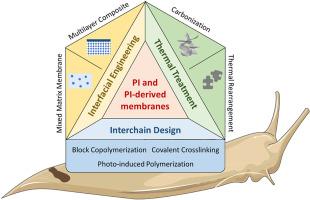Research progress and challenges in polyimide and polyimide-derived gas separation membranes: A review
IF 9.5
引用次数: 0
Abstract
Polyimide (PI) has been widely regarded as an ideal material for high-performance gas separation membranes due to its exceptional mechanical strength, thermal and chemical stability, excellent film-forming properties, and versatile structural tunability. However, practical applications of PI membranes have been limited by challenges such as free volume collapse, physical aging, and high gas transport resistance. These issues are considered to be addressable through the precise regulation of polymer structures via both physical and chemical modification strategies. In this review, the influence of conventional monomer structures on the gas separation performance of PI membranes is examined. Recent advances in modification techniques such as copolymerization, covalent crosslinking, thermal treatment, polymer blending, multilayer composite fabrication, and photo-induced processing are systematically discussed. The structure-property relationships resulting from these modifications are analyzed, with emphasis placed on gas transport mechanisms, as well as the advantages and limitations of each approach. Furthermore, the application potential of PI-derived membranes is highlighted in key areas such as CO2 capture, H2 purification, He enrichment, and light hydrocarbon separation. Through the summarization of current design strategies and performance optimization methods, this review is intended to offer new insights and guidance for the development of next-generation PI-based gas separation membranes.

聚酰亚胺及聚酰亚胺衍生气体分离膜的研究进展与挑战
聚酰亚胺(PI)由于其优异的机械强度、热稳定性和化学稳定性、优异的成膜性能和多种结构可调性,被广泛认为是高性能气体分离膜的理想材料。然而,PI膜的实际应用受到诸如自由体积崩塌、物理老化和高气体输送阻力等挑战的限制。这些问题被认为是可以通过物理和化学改性策略来精确调节聚合物结构来解决的。本文综述了传统单体结构对PI膜气体分离性能的影响。系统地讨论了改性技术的最新进展,如共聚、共价交联、热处理、聚合物共混、多层复合材料制造和光诱导加工。分析了这些改进所产生的结构-性质关系,重点分析了气体输运机制,以及每种方法的优点和局限性。此外,pi衍生膜在CO2捕获、H2净化、He富集和轻烃分离等关键领域的应用潜力得到了强调。通过对现有设计策略和性能优化方法的总结,旨在为下一代pi基气体分离膜的开发提供新的见解和指导。
本文章由计算机程序翻译,如有差异,请以英文原文为准。
求助全文
约1分钟内获得全文
求助全文

 求助内容:
求助内容: 应助结果提醒方式:
应助结果提醒方式:


